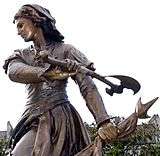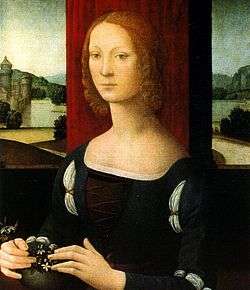Women in post-classical warfare
A variety of roles were played by women in post-classical warfare. James Illston says "the field of medieval gender studies is a growing one, and nowhere is this expansion more evident than the recent increase in studies which address the roles of medieval women in times of war....this change in research has been invaluable". He provides a 20-page bibliography of dozens of recent scholarly books and articles, most of them connected to the crusades.[1] See also Women in the Crusades.
Timeline
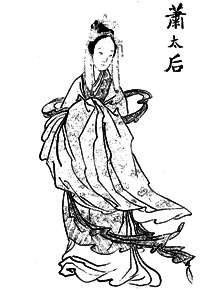
Empress Xiao Yanyan
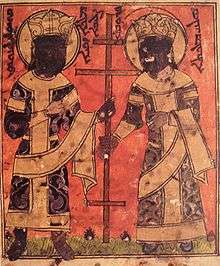
Hulagu Khan with Doquz Khatun
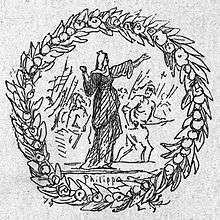
Philippa of England commands the defenders of Copenhagen (1428)
5th century
- 4th–6th century: Possible time period that the legendary woman warrior Hua Mulan may have lived.[2]
- 450 – A Moche woman was buried with two ceremonial war clubs and twenty-eight spear throwers. The South American grave is discovered in 2006, and is the first known grave of a Moche woman to contain weapons.[3]
- 451: Saint Genevieve is credited with averting Attila from Paris by rallying the people in prayer.[4]
6th century
- 6th century: A Saxon woman is buried with a knife and a shield in Lincolnshire, England.[5]
- 6th century: Lady Xian personally leads her army in China.[6]
- 589:[7] The royal nuns Basina, daughter of Chilperic I, and Clotilda rebel and take power in the city of Poitiers by the use of an army of criminals.[8]
7th century
- 7th century (before 637): Life of Mo Chua of Balla. The account of his life describe him as converting two violent "Amazons" named Bee and Lithben.[9][10]
- 617–618: Princess Pingyang of China helps overthrow the Sui Dynasty by organizing an "Army of the Lady".[11]
- 624: Battle of Badr. Qurayshi Arab priestess Hind bint Utbah leads her people against Muhammad in the fight. Her father, uncle, and brother are killed.[12] Rufaida Al-Aslamia, the first Muslim nurse, attends to the wounded.[13]
- 625: Hind bint Utbah is among fifteen women accompanying troops in a battle near Medina, singing songs to inspire warriors. She exults over the body of the man who killed her father, chews his liver, and makes jewelry from his skin and nails.[14]
- 625: Nusaybah bint Ka'ab fights in the Battle of Uhud on behalf of Muhammad after converting to Islam.[15] Hammanah bint Jahsh also participated in the Battle of Uhud and provided water to the needy, and treated the wounded and injured.[16] Umm Sulaym bint Milhan entered the battle carrying a dagger in the folds of her dress, and tended to the wounded. She also made attempts to defend Muhammad when the tide of the battle turned against him.[17]
- 627: Umm Sulaym bint Milhan participates in the Battle of the Trench carrying a dagger in her robes. When Muhammad asked her what she was doing with it, she informed him that she planned to use it to fight deserters.[17]
- 630s:[18] Ghazala leads troops in battle.[19]
- 630s: Khawlah bint al-Azwar participate actively in combat during the Battle of Adnajin dressed as a man along with several other women, takes command of the Rashidun army at the Battle of Yarmouk against the Roman Byzantine Empire. She was nearly beaten by a Byzantine Greek when one of her female companions, Wafayra, beheaded her opponent with one blow. This act rallied the Arabs and they defeated the Greeks.[20]
- 632: Prophetess Sajah, a contemporary of Muhammad, led an army of 4,000 against Medina after his death, but called off the attack when she learned of the defeat of Tulayha.[21]
- 634: Umm Hakim single-handedly disposed of seven Byzantine soldiers with a tent pole during the Battle of Marj al-Saffar.[22]
- 651: Female Sasanian generals like Apranik, Negan and Azedeh fight against the Muslim conquest of Persia.[23]
- 653: Chen Shuozhen leads a peasant rebellion in China, declaring herself empress regnant of China.[24]
- 656: Aisha, widow of Muhammad, leads troops at the Battle of the Camel. She is defeated.[25]
- 690s: Dihya or Kahina leads Berber resistance against the Muslim conquest of the Maghreb.[26]
8th century
- 8th to 11th century (Viking Age): Sagas and historical records tell of Viking shieldmaidens like Lagertha participating in battles and raids,[27] such as Veborg in the Battle of Brávellir in 750.[28][29] In addition, remains of a Birka Viking warrior were confirmed in 2017 by DNA analysis to be female.[30]
- 722: Queen Æthelburg of Wessex destroys the town of Taunton.[31]
- 730: A Khazar noblewoman named Parsbit commands an army against Armenia.[32]
- 769: Gülnar Hatun, a semi-legendary Turkish heroine, is killed fighting the Abbasids.[33][34]
9th century
- 811: After suffering great losses, Khan Krum mobilizes the women of the Bulgars, who then take part in the Battle of Pliska.[35]
- 816-837: Banu, wife of Babak Khorramdin, resists against the Islamic Abbasid Caliphate.[36]
- 880: Ermengard of Italy conducts the defense of Vienne until forced to surrender in September 882.[37]
10th century
- 10th-century: According to legend, Saint Theodora of Vasta, in Arcadia of Peloponnesus, joined the army of Byzantine Empire in her father's stead dressed as a man, to spare her father from conscription, and had no brother who could take his place: when refusing to marry a woman who claimed to have been made pregnant by her, she is executed, resulting in the discovery of the biological gender of her corpse, and her status as a saint for the sacrifice she made for her father.[38]
- 912–922: Reign of Æthelflæd, queen of Mercia. She commanded armies, fortified towns, and defeated the Danes. She also defeated the Welsh and forced them to pay tribute to her.[39]
- 914: Queen Sugandha and her forces marched against the Tantrins. She was defeated and deposed.[40]
- 960: Ethiopian queen Gudit laid waste to Axum and its countryside, destroyed churches and monuments, and attempted to exterminate the members of the ruling dynasty of the Kingdom of Aksum.[41][42]
- 971: Sviatoslav I of Kiev attacked the Byzantine Empire in Bulgaria in 971. When the Varangians were defeated in the siege of Dorostolon, the victors were stunned to discover shieldmaidens among the fallen warriors.[43]
- 975: Adelaide-Blanche of Anjou, acting for her sons Guy and Bertrand, led an army to aid Guy (a.k.a. Guido II), Count-Bishop of le Puy, in establishing the "Peace of God" in le Puy.[44]
- 986: The Khitan Dowager Regent Empress Xiao Yanyan of the Khitan Liao state, regnal title Chengtian, assumes power at age 30 in 982. In 986, personally led her own army against the Song dynasty and defeated them in battle.[45][46][47][48][49]
11th century
- Early 11th century: Freydís Eiríksdóttir, a Viking woman, sails to Vinland with Þorfinnr "Karlsefni" Þórðarson. When she faced hostile natives while pregnant, she exposed her breasts and beat her chest with a sword. This caused the natives to run away.[50]
- 1016: Adela of Hamaland defend the fortress Uplade in the Netherlands in the absence of her spouse, and fills out the ranks of her defense force with women dressed as soldiers.[51]
- 1047: Akkadevi, an Indian princess, besieges the fort of Gokage.[52]
- 1050: Norwegian noblewoman Bergljot Håkonsdatter raise an army to kill the king for murdering her spouse and son: she takes the king's estate, but by then the king had manage to escape her.[53]
- 1055: Defeat and execution of A Nong, Zhuang ruler, warrior, and shamaness. Alongside her son, father, and husband, she led the Zhuang and Nùng minorities of the Sino-Vietnamese frontier against Vietnamese and Chinese foes.[54]
- 1058–1086: Sikelgaita of Salerno, second wife of Robert Guiscard, Duke of Apulia, accompanies her husband on military campaigns, and regularly puts on full armor and rides into battle at his side.[55]
- 1071: Richilde, Countess of Hainaut is captured fighting in the Battle of Cassel.[56]
- 1072: Urraca of Zamora, Infanta of the Kingdom of Castile, defends the city of Zamora against her brother, Sancho.[57]
- 1087: Matilda of Tuscany personally leads a military expedition to Rome in an attempt to install Pope Victor, but the strength of the imperial counterattack soon convinced the pope to retire from the city.[58]
- 1090: Norman woman Isabel of Conches rides on horseback, armed .[59]
- 1097: Florine of Burgundy participates in the first crusade with her spouse, and fell participating in actual combat by his side while their army was attacked and destroyed in Anatolia.[60]
12th century
- 1101: Ida of Formbach-Ratelnberg leads her own army in the Crusade of 1101.[61]
- 1121: Urraca of León fights her half-sister, Theresa, Countess of Portugal when she refuses to surrender the city of Tui, Pontevedra.[62]
- 1130: Female Chinese general Liang Hongyu, wife of general Han Shizhong of the Song Dynasty, blocks the advance of the Jin army with her husband. Her drumming invigorated the Song army and rallied them to defeat the Jin.[63]
- 1136: Welsh princess Gwenllian ferch Gruffydd leads an army against the Normans. She is defeated and killed.[64]
- 1141: Matilda of Boulogne raises an army to continue the fight for the crown of England, after her husband, King Stephen is captured by the Empress Matilda.[65]
- 1145: Eleanor of Aquitaine accompanies her husband on the Second Crusade.[66]
- 1147: Fannu, an Almoravid princess, participate in the defense of the Almoravid dynasty capital's fortress in Marrakech dressed as a man during the conquest of the Almohad jihad.[67]
- 1150: The Swedish nobleman Jon Jarl are killed by Baltic pirates who attacks his estate Askenös after his return from the First Swedish Crusade, after which his widow, the Lady of Askanäs (her name is not preserved), flee to Hundhammar, gather an army and return to kill the murderers of her spouse.[68]
- 1170–1176: Aoife MacMurrough conducts battles in Ireland on behalf of her consort Richard de Clare, 2nd Earl of Pembroke and is sometimes known as "Red Eva".[69]
- 1180–1185: Female Japanese warrior Tomoe Gozen fights in the Genpei War alongside men.[70]
- 1182–1199: Hōjō Masako rides with her spouse Minamoto no Yoritomo on his campaigns and was never defeated in battle.[71]
- 1191–1217: Nicola de la Haye defended loyalist interests against rebel barons in Lincoln, England.[72]
- 1198: Maud de Braose defends Plainscastle against Welsh attack.[73]
- Late 12th-century: Umadevi, consort of King Veera Ballala II, commanded Mysore armies against the rival Chalukyas on at least two occasions,[74] allowing Bellala to concentrate on administrative matters and thus significantly contributing to the Hoysalas' conquest[75] of the Chalkyua at Kalyani (near present-day Bidar).
13th century
- 1201: Japanese woman Hangaku Gozen defends a fort as an archer until she is wounded by an arrow.[76]
- 1226: Yesui, one of the wives of Genghis Khan accompanies her husband as he set out on a punitive expedition to the Tangut kingdom.[77]
- 1220s: Yang Miaozhen acts as war leader in China.[78][79]
- 1236–1239: Reign of Razia Sultana.[80] She led her troops in battle.[81]
- 1258: Doquz Khatun accompanies her husband Hulagu on campaigns. At the Sack of Baghdad in 1258, the Mongols massacred tens of thousands of inhabitants, but by the order of Doquz, the Christians were spared.[82]
- 1261–1289: Reign of Indian queen Rudrama Devi. She leads her troops in battle, and may have been killed in battle in 1289.[83]
- 1264: Eleanor of Provence raises troops in France for her husband during the Baron's War.[84]
- 1270: Eleanor of Castile accompanies her husband on his crusade. According to legend, she saved his life by sucking poison from his wound when he was injured.[85]
- 1271: Isabella of Aragon, Queen of France dies at Cosenza on the way back from the Crusades.[86]
- 1285: Mercadera, dressed as a man, wounds and captures a French knight during the French siege of the Aragonese city of Peralada.[87]
- 1290: Royal Armouries Ms. I.33 is written. It depicts fighters. An illustration of a woman named Walpurgis training in sword and buckler techniques is in the manuscript among others.[88]
- 1296: Bertha van Heukelom defends Castle IJsselstein against Hubrecht van Vianen of Culemborg[89]
- 1297: Joan I of Navarre, Countess of Champagne, leads an army against the Count of Bar when he invaded her domain Champagne.[90]
- Late 13th century: Khutulun, a relative of Kublai Khan, is described as a superb warrior and accompanies her father Khaidu on military campaigns.[91]
14th century
- 14th century: Urduja, a Filipino princess, takes part in several battles. Many historians believe that she was mythical, however.[92]
- 14th century: Women of the Mississippian Culture in the Central Illinois River Valley Region participated in warfare, defending their camp, if needed, while men were out hunting.[93]
- 1326: Isabella of France invades England with Roger de Mortimer, and overthrows Edward II of England, replacing him with her son Edward III of England, with her and de Mortimer acting as regents.[94]
- 1335: During the Second War of Scottish Independence Christina Bruce commanded the garrison of Kildrummy Castle and successfully held the castle against pro-Baliol forces led by David III Strathbogie.[95]
- 1335: The Scots defeat a company led by the Count of Namur. Amongst the Count's casualties was a female lancer who had killed her opponent, Richard Shaw, at the same moment that he had killed her. Her gender was only discovered when the bodies were being stripped of their armor at the end of the engagement. "The chronicler Bower seems to have been at least as impressed by the rarity of two mounted soldiers simultaneously transfixing one another with their lances as with the fact that one of them was a woman."[96]
- 1338: Agnes Randolph successfully defends her castle against a siege by England's earl of Salisbury.[97]
- 1342–1343: Joanna of Flanders conquers the city of Redon and defends the city of Hennebont during the Breton war.[98]
- 1341-1347: Empress Irene Asanina commands the garrisson of Didymoteicho and defend the city during the Byzantine civil war of 1341–1347.[99]
- 1348: Empress Irene Asanina organize the defense of Constantinople against the Geneuse.[100]
- 1351–1363: Han E serves as a soldier in the Chinese army as a man under the name Han Guanbao, and is promoted to lieutenant.[101]
- 1351–1357: Cia Ordelaffi née Marzia degli Ubaldini an Italian noblewoman from Forlì came in help of Lodovico Ordelaffi during the battle of Dovadola (part of the Guelphs and Ghibellines war). In 1357 she took part in the defense of Cesena during the Forlivesi crusade induced by Pope Innocent VI.[102]
- 1353: Empress Irene Asanina organize the defense of Constantinople against the army of John V.[103]
- 1354: Ibn Battuta reports seeing female warriors in Southeast Asia.[104]
- 1358: Richardis of Schwerin defends Sönderborg Castle on Als against Valdemar IV of Denmark.[105]
- 1364–1405: Timur uses female archers to defend baggage trains.[104]
- 1387: Queen Jadwiga of Poland leads two military campaigns.[106]
- 1389: Frisian regent Foelke Kampana leads armies to assist her spouse Ocko Kenisna tom Brok, chief of Auricherland: after finding him dead on the battlefield, she returns to Aurich, and upon finding it taken by an enemy during her absence, she retakes it by military force.[107]
15th century
- 1419: Margaret of Bavaria defend French Burgundy against John IV, Count of Armagnac.[108]
- 1420: Tang Sai'er starts a rebellion against the emperor of China and take two cities with her rebel army before she is defeated.[24]
- 1428: Cecília Rozgonyi commanded her own ship in battle toward the Ottoman Empire under Sigismund of Hungary at Golubac fortress.[109]
- 1428: Philippa of England, Queen of Denmark, successfully organized the defence of Copenhagen against the Hanseatic League, a heroic feat later recounted by Hans Christian Andersen in Godfather's Picture Book (1868).[110]
- 1429: Joan of Arc asserts that God has sent her to drive the English out of France, and is given a position in the French Royal army.[111] She is supported by Yolande of Aragon, mother of Queen Marie d'Anjou (wife of King Charles VII).[112]
- 1430s: Jeanne des Armoises was a soldier in Italy.[113]
- 1430: Aldonça de Bellera defend her barony of Rialp in Catalonia against count Arnau Roger of IV Pallars.[114]
- 1433: Ida Königsmarck legendary defense her fief Kastelholm Castle on Åland in Swedish Finland during the Engelbrekt rebellion.[115]
- 1450s: Zaydi Yemeni chieftain Sharifa Fatima conquers San'a'.[116]
- 1451–1452 : Brita Tott serves as a spy in the war between Sweden and Denmark[117]
- 1455: Elise Eskilsdotter leads a war against the German merchant class of Bergen in Norway as revenge for the murder of her spouse, by means of her pirate fleet.[118]
- 1461: Alice Knyvet defends Buckingham Castle at Norfolk against Sir Gilbert of Debenhem.[119]
- 1467: Ólöf Loftsdóttir personally leads the war against the English on Iceland.[120]
- 1471: Queen Margaret of Anjou personally leads her troops in the Battle of Tewkesbury.[121]
- 1472: Onorata Rodiana from Cremona, Italy is mortally wounded in battle. She had disguised herself as a man to become a soldier.[122]
- 1472: Jeanne Hachette rips down the flag of the invading Burgundians at Beauvais, inspiring the garrison to win the fight.[123]
- 1474: Caterina d'Ortafà participate in the defense of Canet-en-Roussillon during the French invasion of Roussilon following the Catalan Civil War.[124]
- 1480: Margareta of Celje defends the city of Glogow against the forces of the duke of Sagan, who lay siege to the town.
- 1480s: Mandukhai Khatun takes command of the Mongol army and defeats the Oirats.[125]
- 1481: Dutch noblewoman Swob Sjaarda defends her castle during a siege in the Netherlands.[126]
- 1487: Katarina Nipertz defends Raseborg Castle in Finland, the fief of her late spouse, against the troops of the new vassal appointed by the regent, for several weeks.[127]
- 1494: Ats Bonninga defends her fort in Friesland.[128]
- 1496: Bauck Poppema defends her fort in Friesland.[129]
- 1499: Caterina Sforza successfully defends Forli against a Venetian attack and become famous and nicknamed "The Tiger".[130]
gollark: Other OSes can just ignore the permissions, is the thing.
gollark: The designers obviously did not want unprivileged users to be able to arbitrarily make themselves have permissions.
gollark: I doubt it's possible from within MacOS for obvious security reasons, but if you can boot into a Linux USB stick or something you can edit it from there.
gollark: There are even tons of copies on github, including one memorably added to the repository of DMCAs via a bug they won't patch.
gollark: And the Arch one and probably other distros', it's not going to vanish from anywhere else.
See also
- Timeline of women in ancient warfare
- Timeline of women in early modern warfare
References
- James Michael Illston, "'An Entirely Masculine Activity'? Women and War in the High and Late Middle Ages Reconsidered," (Thesis, Department of History, University of Canterbury, 2009) p. 1
- Folktales and Fairy Tales: Traditions and Texts from around the World, 2nd edition. edited by Anne E. Duggan Ph.D., Donald Haase Ph.D., Helen J. Callow p.674
- "A Peruvian Woman of AD 450 Seems to Have Had Two Careers by John Noble Wilford, New York Times, May 17, 2006". The New York Times. 17 May 2006. Retrieved 25 May 2010.
- Hayward, John (1857). The Book of Religions: Comprising the Views, Creeds, Sentiments, Or Opinions of all the Principal Sects in the World, Particularly of All Christian Denominations in Europe and America to which are added Church and Missionary Statistics together with Biographical Sketches. Boston: Sanborn, Carter, Bazin and Company. p. 428.
- "South Carlton Lincolnshire, 25 January 2004: Saxon Burials on the Ridge from channel.4.com". Archived from the original on 15 December 2010. Retrieved 7 May 2008.
- Liu, Monica. "Militarist Lady Xian: the guardian of Lingnan people_History_www.newsgd.com". www.newsgd.com.
- People, Personal Expression, and Social Relations in Late Antiquity, Volume 1, Ralph W. Mathisen University of Michigan Press, 2003 - Foreign Language Study. p.234
- Gregory of Tours. "Chapter 15". Historia Francorum. Book X.
-

-

- Peterson, Barbara Bennett, editor in chief; He Hong Fei; Wang Jiu; Han Tie; Zhang Guangyu; Associate editors (2000). Notable Women of China: Shang Dynasty to the Early Twentieth Century. M.E. Sharpe Inc., New York. p. 177. ISBN 978-0-7656-0504-7.
- Olsen, Kirstin (1994). Chronology of women's history. Greenwood Publishing Group. p. 31. ISBN 978-0-313-28803-6.
- Al-Hassani, Salin TS. "Women's Contribution to Classical Islamic Civilisation: Science, Medicine, and Politics". Muslim Heritage. Retrieved 24 November 2013.
- Olsen, p. 31
- Girl Power. ABC News. Archived 15 December 2010 at WebCite
- Role of Muslim woman in society, Afzal-ur-Rahman Seerah Foundation, 1986, p.74
- Singh, N.K (August 2003). Prophet Muhammad And His Companions. ISBN 9788187746461. Retrieved 16 July 2013.
- For God's Sake By Jane Caro, Antony Loewenstein, Simon Smart, Rachel Woodlock
- Leila Ahmed, Women and Gender in Islam: Historical Roots of a Modern Debate (Yale University Press, 1992) p.71
- Hale, Sarah Josepha Buell (1853). Woman's Record: Or, Sketches of All Distinguished Women, from "The Beginning Till A.D. 1850, Arranged in Four Eras, with Selections from Female Writers of Every Age. Harper Brothers. p. 120.
- Historical Dictionary of Women in the Middle East and North Africa By Ghada Talhami, p.287
- Ahmed, Leila (1992). Women and Gender in Islam: Historical Roots of a Modern Debate. ISBN 978-0300055832. Retrieved 16 July 2013.
- Harrel, John (2016). The Nisibis War: The Defence of the Roman East AD 337-363. Pen and Sword. p. 69. ISBN 9781473848337. Retrieved 14 April 2018.
- Lily Xiao Hong Lee, Sue Wiles: Biographical Dictionary of Chinese Women, Volume II: Tang Through Ming 618 - 1644
- Black, Edwin (2004). Banking on Baghdad: Inside Iraq's 7,000 Year History of War, Profit, and Conflict. John Wiley and Sons. p. 34. ISBN 978-0-471-70895-7.
- Hannoum, Abdelmajid (2001). Post-Colonial Memories: The Legend of the Kahina, a North African Heroine (Studies in African Literature). ISBN 978-0-325-00253-8.
- Otté, Elise C. (1874). Scandinavian History. Macmillan & co. p. 28.
- Macculloch, J.A. (2005). The Celtic and Scandinavian Religions. Cosimo, Inc. p. 125. ISBN 978-1-59605-416-5.
- Lindquist, Herman. Historien om Sverige ("History of Sweden"), Book (In Swedish).
- "Viking warrior from Birka grave confirmed as female". Archaeology News from Past Horizons. 8 September 2017. Archived from the original on 8 September 2017. Retrieved 16 September 2017.
- Ashley, Mike (1998). The Mammoth Book of British Kings and Queens. London: Robinson Publishing. p. 309.
- Golden, Peter (1980). Khazar Studies: An Historio-Philological Inquiry into the Origins of the Khazars. Budapest: Akademia Kiado.
- Merkezi, T.C. MİLLÎ EĞİTİM BAKANLIĞI MERSİN / GÜLNAR / Halk Eğitim. "T.C. MİLLÎ EĞİTİM BAKANLIĞI MERSİN / GÜLNAR / Halk Eğitim Merkezi". gulnarhem.meb.k12.tr. Archived from the original on 4 March 2016. Retrieved 11 July 2016.
- "Gülnar Belediyesi". www.gulnar.bel.tr.
- Regan, Geoffrey (2000). The Brassey's book of military blunders. Brassey's Inc, Dulles, Virginia. pp. 68. ISBN 978-1-57488-252-0.
- Kaveh Farrokh, The Persian Lioness: Iranian Women in History
- Bury, J.B. (1922). Cambridge Medieval History. Macmillan. Vol. III, p. 58; Blair, John; J. Willoughby Rosse (1856). Blair's Chronological Tables, Revised and Enlarged: Comprehending the Chronology and History of the World from the Earliest Times to the Russian Treaty of Peace, April 1856. H.G. Bohn, York Street, Convent Garden, London. p. 300.
- Hellēnikē Archaiometrikē Hetaireia. Symposium, Giór̄gos Fakoréllis̄, Nikos Zacharias, Kiki Polikreti: Proceedings of the 4th Symposium of the Hellenic Society for Archaeometry: National Hellenic Research Foundation, Athens, 28–31 May 2003, Archaeopress, 2008
- King, William C. (1902). Woman; Her Position, Influence, and Achievement Throughout the Civilized World. Her Biography and History. The King-Richardson co., Springfield, Massachusetts. p. 177.
- Culture and Political History of Kashmir, Volume 1 By P. N. K. Bamzai p.140
- Gudit. The Dictionary of Ethiopian Biography, Vol. 1 'From Early Times to the End of the Zagwé Dynasty c. 1270 A.D.,' copyright © 1975
- The Queen of the Habasha in Ethiopian History, Tradition and Chronology. School of Oriental and African Studies.
- Harrison, D. & Svensson, K. (2007). Vikingaliv. Fälth & Hässler, Värnamo. ISBN 978-91-27-35725-9. p. 71
- Jerome Kroll, Bernard S. Bachrach, Medieval Dynastic Decisions: Evolutionary Biology and Historical Explanation, The Journal of Interdisciplinary History,, Vol. 21, No. 1 (Summer, 1990), p. 9
- Peterson, Barbara, ed. (2000). Notable Women of China. M. E. Sharpe. p. 259. ISBN 9780765619297. Retrieved 6 October 2014.
- Van Derven, H. J., ed. (2000). Warfare in Chinese History. Brill. p. 199. ISBN 978-9004117747. Retrieved 6 October 2014.
- Bauer, Susan (2010). The History of the Medieval World: From the Conversion of Constantine to the First Crusade. p. 569. ISBN 9780393078176. Retrieved 6 October 2014.
- Wang, Yuan-kang (2013). Harmony and War: Confucian Culture and Chinese Power Politics. ISBN 9780231522403. Retrieved 6 October 2014.
- Keay, John (2010). China: A History. HarperCollins. p. 79. ISBN 9780007372089.
- Thrapp, Dan L. (1991). Encyclopedia of Frontier Biography: In Three Volumes. University of Nebraska Press. p. 521. ISBN 978-0-8032-9418-9.
- Bronvermelding: Anton Kos, Adela van Hamaland, in: Digitaal Vrouwenlexicon van Nederland. URL: http://resources.huygens.knaw.nl/vrouwenlexicon/lemmata/data/Adela%5B%5D van Hamaland [13/01/2014]
- Campbell, James M.; R. E. Enthoven (1904). Gazetteer of the Bombay Presidency, Volume I, Part II, History of the Konkan Dahkan and Southern Maratha Country. Govt. Central Press, Bombay, India. p. 435.
- Krag, Claus. (2009, 13. februar). Bergljot Håkonsdatter. I Norsk biografisk leksikon. Hentet 27. August 2016 fra https://nbl.snl.no/Bergljot_H%C3%A5konsdatter.
- Barlow, Jeffrey G. (2002), "A Nong (c. 1005–1055)", in Commire, Anne (ed.), Women in World History: A Biographical Encyclopedia, Waterford, Connecticut: Yorkin Publications, ISBN 978-0-7876-4074-3.
- Grant DePauw, Linda (2000). Battle Cries and Lullabies: Women in War from Prehistory to the Present. University of Oklahoma Press. p. 86. ISBN 978-0-8061-3288-4.
- Saunders, Corinne J.; Françoise Hazel Marie Le Saux; Neil Thomas (2004). Writing War: Medieval Literary Responses to Warfare. DS Brewer. p. 190. ISBN 978-0-85991-843-5.
- Williams, Henry Smith (1908). The Historians' History of the World. Hooper & Jackson. p. 611.
- Kirsch, Johann Peter. "Matilda of Canossa" – via Wikisource.
- Edgington, Susan; Sarah Lambert (2002). Gendering the Crusades. Columbia University Press. pp. 53–54. ISBN 978-0-231-12598-7.
- Histoire des l'Académie Royale des Inscriptions et Belles Letres, Paris, 1736, t.IX, p.196.
- Steven Runciman: Geschichte der Kreuzzüge. München 1978 (Sonderausgabe), S. 341
- Stephens, H. Morse (1891). The Story of the Nations: Portugal. New York, G.P Putnam's Sons, London, T. Fisher Unwin. p. 29.
- Jinhua Dai; Jing Wang; Tani E. Barlow (2002). Cinema and Desire: Feminist Marxism and Cultural Politics in the Work of Dai Jinhua. Verso. p. 147. ISBN 978-1-85984-264-5.
- Lloyd, John E. (1935). A History of Carmarthenshire. Pub. Caerdydd. p. 140.
- Marjorie Chibnall, « Matilda (1102–1167) », Oxford Dictionary of National Biography, Oxford University Press, 2004.
- Weiss, Sonia; Lorna Biddle Rinear; Contributor Adriana Leshko (2002). The Complete Idiot's Guide to Women's History. Alpha Books. p. 87. ISBN 978-0-02-864201-7.
- Emmanuel Kwaku Akyeampong & Henry Louis Gates: Dictionary of African Biography, Volym 6
- Eric Chronicles
- Igoe, Brian (2013). The Story of Ireland
- Deal, William E. (2007). Handbook to Life in Medieval and Early Modern Japan. Oxford University Press, US. p. 48. ISBN 978-0-19-533126-4.
- Jones 1997, pp. 37–38
- Wilkinson, Linda (2007) Women in Thirteenth-Century Lincolnshire, Woodbridge: Royal Historical Society, Boydell Press; chapter 1. ISBN 0861932854
- MHRA Tudor & Stuart Translations: Vol. 5: The Breviary of Britain By Humphrey Llwyd, p.163
- Shek Ali, Dr. B., ed., The Hoysala Dynasty, Mysore, 1977.
- Derrett, J. D. M., The Hoysalas, London, 1957.
- Friday, Karl F. (2003). Samurai, Warfare and the State in Early Medieval Japan: a military study. Routledge. p. 193. ISBN 978-0-415-32962-0.
- The Rise and Fall of the Second Largest Empire in History: How Genghis Khan's Mongols Almost Conquered the World By Thomas J. Craughwell p.159
- Lee, Lily Xiao Hong; Wiles, Sue (13 March 2014). Biographical Dictionary of Chinese Women: Tang Through Ming, 618-1644. M.E. Sharpe. pp. 545–547. ISBN 9780765643162. Retrieved 8 November 2017.
- Lorge, Peter A. (5 December 2011). Chinese Martial Arts: From Antiquity to the Twenty-First Century. Cambridge University Press. pp. 153–154. ISBN 9781139502559.
- The Pearson Guide To The Central Police Forces Examination, 2/E By Thorpe, p.3.8, written 2010
- History of the Panjáb from the Remotest Antiquity to the Present Time By Muḥammad Laṭīf (Saiyid, khān bahādur.), p.98 Written 1891.
- "A history of the Crusades", Steven Runciman, ISBN 978-0-14-013705-7, p.303
- Ramusack, Barbara N.; Sharon L. Sievers (1999). Women in Asia: Restoring Women to History. Indiana University Press. ISBN 978-0-253-21267-2.
- Houghton Mifflin Company; Justin Kaplan (2003). The Houghton Mifflin Dictionary of Biography. p. 487. ISBN 978-0-618-25210-7.
- Low, Sidney James; Frederick Sanders Pulling (1910). The Dictionary of English History. Cassell and Company Limited, London, New York, Toronto, and Melbourne. p. 421.
- Williamson, Paul (1998). Gothic Sculpture, 1140-1300. Yale University Press. p. 171. ISBN 978-0300074529.
- «Diccionari Biogràfic de Dones: Mercadera, na»
- Bachmann, Dieter (2003). "I.33". Archived from the original on 15 December 2010. Retrieved 20 June 2008.
- djr (20 March 2017). "Digitaal Vrouwenlexicon van Nederland". www.inghist.nl.
- Woodacre, Elena (5 September 2013). The Queens Regnant of Navarre: Succession, Politics, and Partnership, 1274-1512. Palgrave Macmillan. p. 21. ISBN 978-1-137-33915-7. Retrieved 9 January 2015.
- Rossabi, Morris (1989). Khubilai Khan: His Life and Times. University of California Press. pp. 104–105. ISBN 978-0-520-06740-0.
- Apeles, Teena (2004). Women Warriors: Adventures from History's Greatest Female Fighters. Seal Press. p. 65. ISBN 978-1-58005-111-8.
- Bengtson, J.; O'Gorman, J. (6 June 2016). "Women's Participation in Prehistoric Warfare: A Central Illinois River Valley Case Study". International Journal of Osteoarchaeology. 27 (2): 230–244. doi:10.1002/oa.2532. ISSN 1047-482X.
- American Heritage Dictionary Editors (2005). The Riverside Dictionary of Biography. Houghton Mifflin Reference Books. p. 410. ISBN 978-0-618-49337-1.
- A History of the County of Renfrew from the Earliest Times By William Musham Metcalfe p.69-70
- Brown, Chris (2006). The Second Scottish Wars of Independence. Tempus Publishing. p. 60. ISBN 978-0-7524-3812-2.
- Lawson, John Parker (1849). Historical Tales of the Wars of Scotland and of the Border Raids, Forays, and Conflicts. Edinburgh. p. 1:89
- Butler, Pierce, Women of Medieval France, Chapter IX, Barrie, London 1907.
- Lynda Garland:Byzantine Empresses: Women and Power in Byzantium AD 527-1204
- Lynda Garland:Byzantine Empresses: Women and Power in Byzantium AD 527-1204
- "Han E - the 'Hua Mulan' of Sichuan Province". Colorq.org. Archived from the original on 15 December 2010. Retrieved 3 June 2008.
- "Degli Ubaldini, Cia" (in Italian). Archived from the original on 21 August 2016. Retrieved 4 August 2016.
- Lynda Garland:Byzantine Empresses: Women and Power in Byzantium AD 527-1204
- Svinth, Joseph R. "Women's Martial Arts: A Chronological History, 479 BCE-1896 CE". Electronic Journals of Martial Arts and Sciences Guelph School of Japanese Sword Arts, July 2003. Archived from the original on 15 December 2010. Retrieved 27 June 2008.
- "86 (Dansk biografisk Lexikon / XIV. Bind. Resen - Saxtrup)". runeberg.org.
- Halecki, Oscar (1991). Jadwiga of Anjou and the Rise of East Central Europe. Polish Institute of Arts and Sciences of America. ISBN 0-88033-206-9.
- "Kampana, Foelke (ca. 1355-1417/1419)".
- djr (20 March 2017). "Digitaal Vrouwenlexicon van Nederland". www.inghist.nl.
- Zollner, Anton (1991). "Die Burgen "Sankt Ladislaus" und "Golubatsch"". Mittelalterliche Burgen auf dem Gebiet des rumänischen Banats (in German).
- "Hans Christian Andersen : Godfather's Picture Book". www.andersen.sdu.dk.
- Pernoud, Regine (1982). Joan of Arc By Herself And Her Witnesses. Scarborough House.
- Berents, p.32
- Quest for the past. Pleasantville: Reader's Digest Association. 1984. p. 298. ISBN 978-0-89577-170-4.
- «Diccionari Biogràfic de Dones: Aldonça, de Bellera»
- Engelbrecht Engelbrechtssons historia, Eric Tundeld, 1784
- Mernissi, Fatima (1997). The Forgotten Queens of Islam. Translated by Mary Jo Lakeland. University of Minnesota Press. p. 20. ISBN 978-0-8166-2439-3.
- Wilhelmina Stålberg: Anteqningar om Svenska kvinnor (Notes on Swedish women) (Swedish)
- Svensk uppslagsbok. Malmö 1931.
- "The Secret History of Women". Sunday Mirror. 2 January 2000. Retrieved 20 June 2008.
- „Ólöf ríka á Skarði. Sunnudagsblað Tímans, 28. júní 1964."
- The British Monarchy For Dummies By Philip Wilkinson, p.358
- Waters, Clara Erskine Clement (1886). Stories of Art and Artists. Ticknor and company. pp. 86–87.
- The Encyclopædia Britannica: A Dictionary of Arts, Sciences, Literature and General Information, eleventh edition, volume XII. Cambridge, England, at the University Press, New York 35 West 32nd street. 1910. p. 793.
- «Diccionari Biogràfic de Dones: Caterina, d'Ortafà»
- Davis-Kimball, Jeannine (2002). Warrior Women, An Archaeologist's Search for History's Hidden Heroines. Warner Books Inc. pp. 226–228. ISBN 978-0-446-52546-6.
- djr (20 March 2017). "Digitaal Vrouwenlexicon van Nederland". www.inghist.nl.
- Suomen kansallisbiografia (National Biography of Finland)
- djr (20 March 2017). "Digitaal Vrouwenlexicon van Nederland". www.inghist.nl.
- djr (20 March 2017). "Digitaal Vrouwenlexicon van Nederland". www.inghist.nl.
- Brogi, Cecilia (1996). Caterina Sforza (in Italian). Arezzo: Alberti & C. Editori.
Further reading
Surveys
- De Pauw, Linda Grant. Battle Cries and Lullabies: Women in War from Prehistory to the Present (University of Oklahoma Press, 1998), popular history by a leading scholar
- Fraser, Antonia. The Warrior Queens (Vintage Books, 1990)
Medieval
- Bauer, Susan Wise (2010). The History of the Medieval World: From the Conversion of Constantine to the First Crusade (illustrated ed.). W. W. Norton. ISBN 978-0393078176.
- Blythe, James M. "Women in the Military: Scholastic Arguments and Medieval Images of Female Warriors," History of Political Thought (2001), v.22 pp. 242–69.
- Edgington, Susan B. and Sarah Lambert, eds. Gendering the Crusades (2002), 13 scholarly articles
- Hacker, Barton C. "Women and Military Institutions in Early Modern Europe: A Reconnaissance," Signs (1981), v6 pp. 643–71.
- Hay, David. "Canon Laws Regarding Female Military Commanders up to the Time of Gratian: Some Texts and their Historical Contexts", in A Great Effusion of Blood'? Interpreting Medieval Violence, eds. Mark D. Meyerson, et al. (University of Toronto Press, 2004), pp. 287–313.
- Hay, David. The Military Leadership of Matilda of Canossa, 1046-1115 (Manchester University Press, 2008).
- Hingley, Richard, and Unwin, Christina. Boudica: Iron Age Warrior Queen (2006).
- Illston, James Michael. 'An Entirely Masculine Activity'? Women and War in the High and Late Middle Ages Reconsidered (MA thesis, University of Canterbury, 2009) full text online, with detailed review of the literature
- Lourie, E. "Black women warriors in the Muslim army besieging Valencia and the Cid's victory: A problem of interpretation," Traditio, 55 (2000), 181–209
- McLaughlin, Megan. "The Woman Warrior: Gender, Warfare and Society in Medieval Europe," Women's Studies 17 (1990), pp. 193–209.
- Maier, C.T. "The roles of women in the crusade movement: a survey" Journal of medieval history (2004). 30#1 pp 61–82
- Nicholson, Helen. "Women on the Third Crusade," Journal of Medieval History 23 (1997), pp. 335–49.
- Solterer, Helen. "Figures of Female Militancy in Medieval France," Signs 16 (1991), pp. 522–49.
- Tuotuo. Liaoshi [History of Liao]. Beijing: Zhonghua shuju, 1974 (or Tuotuo, Liaoshi (Beijing: Zhonghua shuju, 1974))
- Verbruggen, J.F. "Women in Medieval Armies," Journal of Medieval Military History 4 (2006), pp. 119–36.
China
- Keay, John (2010). China: A History. HarperCollins UK. ISBN 978-0007372089.
- McMahon, Keith (2013). Women Shall Not Rule: Imperial Wives and Concubines in China from Han to Liao. Rowman & Littlefield Publishers. ISBN 978-1442222908.
- Peterson, Barbara Bennett, ed. (2000). Notable Women of China: Shang Dynasty to the Early Twentieth Century (illustrated ed.). M.E. Sharpe. ISBN 978-0765619297.
- Toqto'a; et al. (1344). Liao Shi (宋史) [History of Liao] (in Chinese).
- Van Derven, H. J., ed. (2000). Warfare in Chinese History. Volume 47 of Sinica Leidensia / Sinica Leidensia (illustrated ed.). BRILL. ISBN 978-9004117747.
- Wang, Yuan-Kang (2013). Harmony and War: Confucian Culture and Chinese Power Politics (illustrated ed.). Columbia University Press. ISBN 978-0231522403.
External links
| Wikimedia Commons has media related to Women in the military. |
This article is issued from Wikipedia. The text is licensed under Creative Commons - Attribution - Sharealike. Additional terms may apply for the media files.

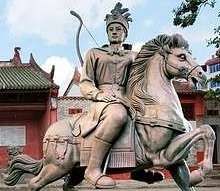
crop.jpg)
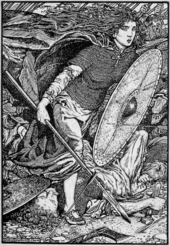

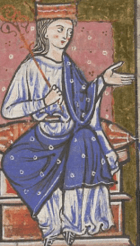
.jpg)


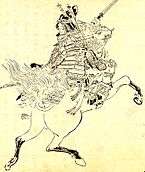
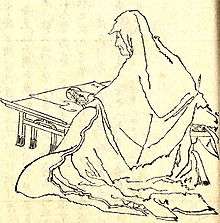
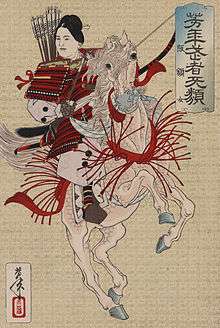

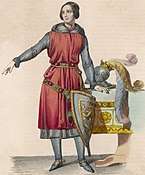
.jpg)

